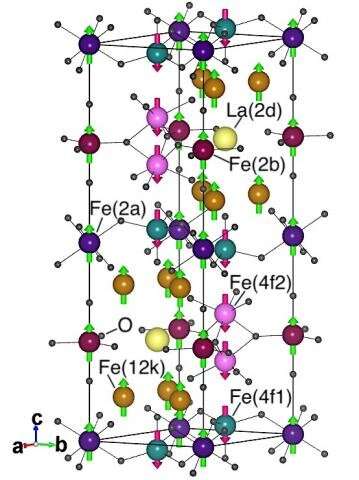A well-known iron-based magnet is also a potential quantum information material

Scientists pursuing better performance in a well-known type of iron-based magnet also discovered wide-gap semiconducting behavior and a quantum state useful for quantum information processing—all in a single low-cost material that has been in existence for decades.
Scientists at the U.S. Department of Energy's Critical Materials Institute, or CMI, study ways to make lower-cost, easier-to-obtain materials used as ingredients in technologies that are in demand now or are developing for the future. In this case, the researchers were investigating ways to create a stronger iron-based permanent magnet, something referred to as a "gap" magnet.
Permanent magnets fall into two broad categories. The strongest-performing permanent magnets contain rare-earth metals like samarium, neodymium, and dysprosium—their properties make them the best and often only choice for applications like computer hard disk drives and motors in hybrid and electric vehicles. These magnets are typically expensive, and their rare-earth components can be difficult to obtain. The second, iron-based permanent magnets, are inexpensive and made of readily available materials, but their performance is often too poor for many advanced applications. In between the high performing rare-earth magnets and low-performing iron-based magnets is a "gap," where there is a great need for permanent magnets that perform in the mid-range of desirable properties. Filling that gap reduces the need for rare-earth magnets, and in turn hard to source rare-earth materials.
The search for a good gap magnet led CMI scientists to take a closer look at a class of magnets, iron hexaferrites, which have been known since the 1950s, to see if they could extend their properties and performance into the gap range.
"These are not easy materials to work with—they are very complex. But we can use computers to excellent advantage in our discovery process and scan the vast number of possibilities for materials that hold the most promise for the properties we want or need," said Durga Paudyal, a CMI scientist who specializes in theoretical and computational condensed matter physics.
This work and others established that lanthanum-based hexaferrites show an advantage over conventional samarium-based hexaferrites. The improved properties and readily available, less expensive ingredients identified LaFe12O19 in particular as an excellent candidate for a gap magnet.
But the computer modeling performed by Paudyal and his team also discovered additional intriguing properties in the material, ones that could play an important role in quantum communications. They discovered the alloy is an excellent wide-bandgap semiconductor, a category of semiconductor that can withstand higher voltages, frequencies, and temperatures, and is highly sought after for the development of new energy conversion technologies. The researchers were also surprised to discover a new quantum state in this material, which strongly locks the magnetization along a fixed direction in the crystal. The chemical similarity of lanthanum to other rare earths suggests that this material can host other rare earths possessing nontrivial localized electronic states, including erbium that is central to fiber-optic communications. These types of localized states are under worldwide exploration to connect signals in quantum computers with those traveling in the fiber-optic cables essential to modern telecommunications.
Michael Flatté, a collaborator on the work from the University of Iowa, is highly excited about the discovery. "Rare earth hosted oxides like these will play an essential role in the discovery and development of new materials for quantum information science and engineering," he said.
"This is an excellent example of the Department of Energy's collaborative research," said CMI Director Tom Lograsso. "Ames Lab and CMI have broad expertise and history in rare earth materials, and researchers in one area may recognize important properties for others, bringing benefits and discoveries to multiple research areas."
The research is further discussed in the paper "Enhanced magnetic anisotropy in lanthanum M-type hexaferrites by quantum-confined charge transfer," authored by Churna Bhandari, Michael E. Flatté, and Durga Paudyal; and published in Physical Review Materials.
More information: Churna Bhandari et al, Enhanced magnetic anisotropy in lanthanum M-type hexaferrites by quantum-confined charge transfer, Physical Review Materials (2021). DOI: 10.1103/PhysRevMaterials.5.094415
Provided by Ames Laboratory





















